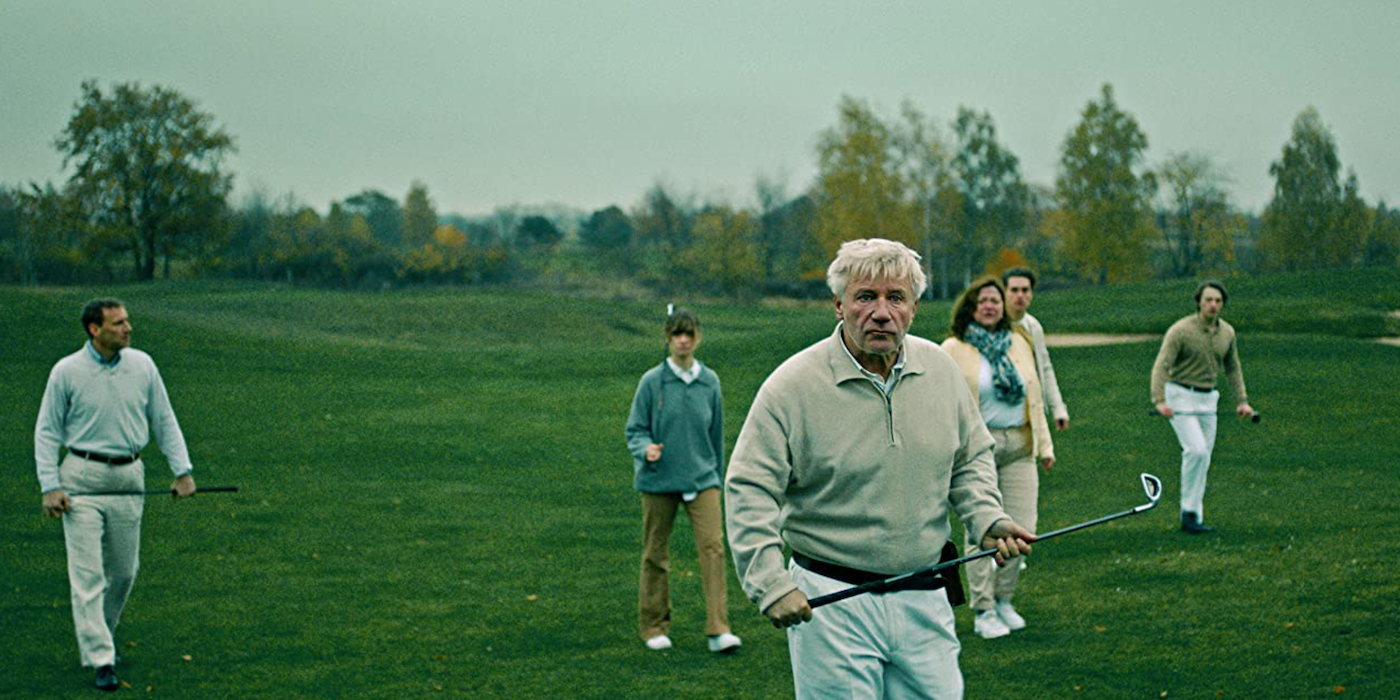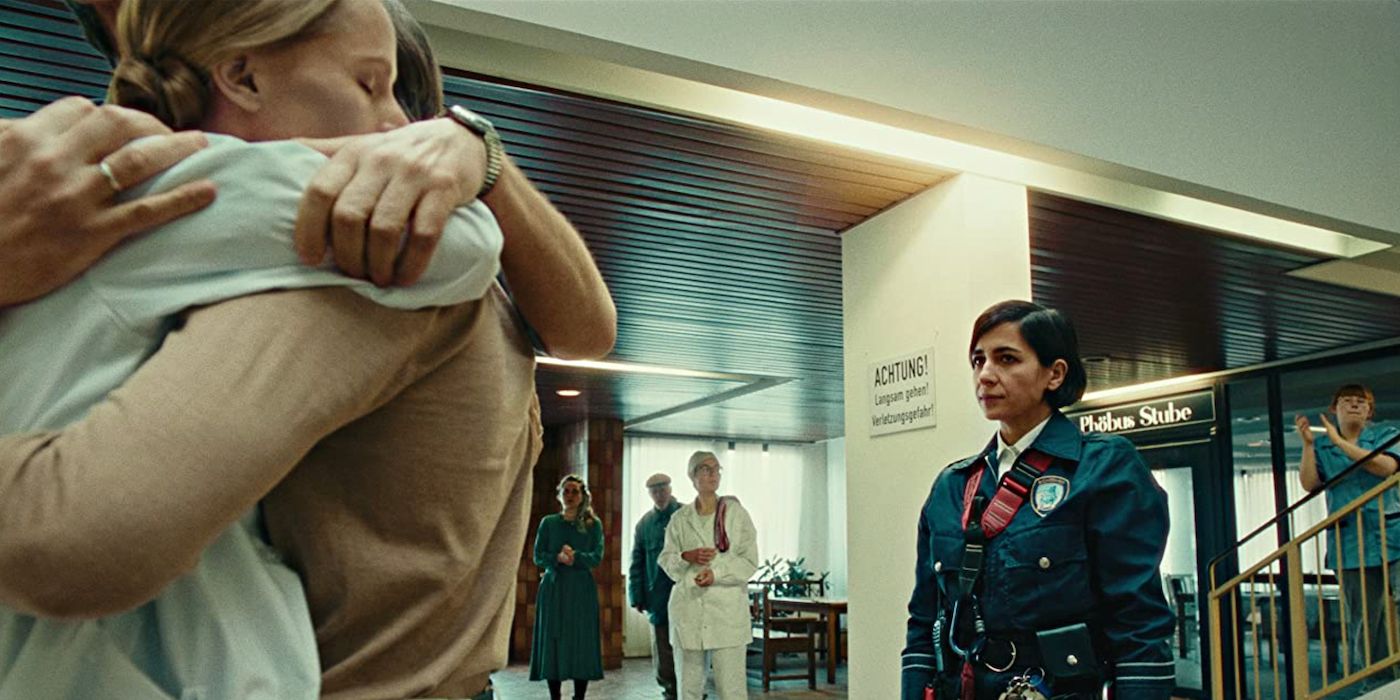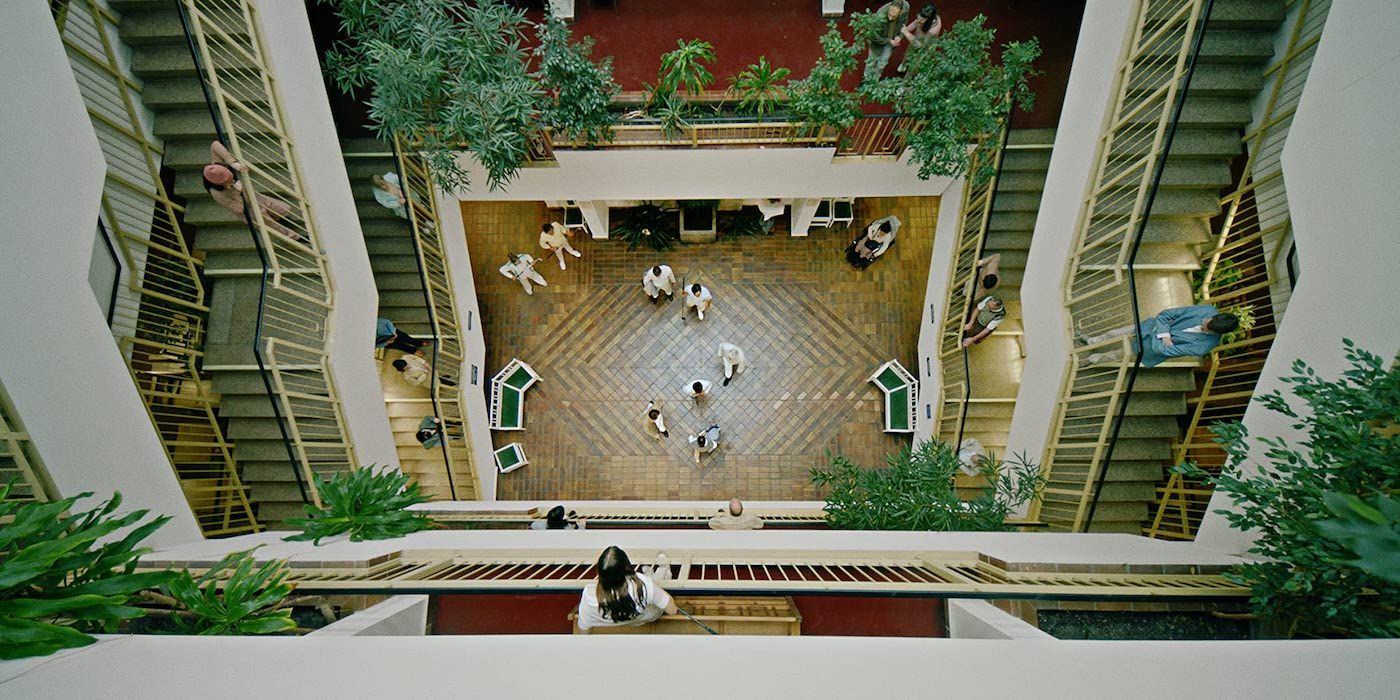This review was originally part of our coverage for the 2022 Fantasia International Film Festival.
Paranoia can be a powerful, all-consuming sickness. It may start small, with whispers and hushed conversations, though it can quickly rise into a roar that can’t be stopped. In her hilarious and haunting debut feature We Might As Well Be Dead, writer-director Natalia Sinelnikova takes a cinematic scalpel to dissect the way such fear can take hold of even the most seemingly rational people. When it does, the very individuals who believe themselves to be logical can begin doing the most illogical of things. Along with her co-writer and collaborator Viktor Gallandi, Sinelnikova reveals how the greatest threats we may be facing actually come from ourselves with our own tendency for terror to cloud our judgment.
The film takes place in a dystopian world of sorts where a singular building is one of the sole places of refuge left. We don’t see much of this outside world, an intentional and intriguing choice as it means we must rely on the deeply unreliable imaginations of those living there. At the center of this is Ioana Iacob’s Anna, a security officer who is tasked with processing applicants to the building and addressing any issues that may arise. In an early scene packed with a dry sense of humor, we see her winding down and quizzing a family looking to move into the building about whether they would be a good fit. She tells them that “not only do you have to be right for us, we also have to be right for you,” as if this is a routine rental application and not the sole place left out there to get shelter. Still, much like the real process of trying to find a place to live, it is dehumanizing and quite dreadful. The father of the family even gets down on his knees and pleads with her, saying that his family are respectful people that smile, joke, and water the flowers. He even pledges that “during sex, we are very quiet and discreet.” The family ends up getting rejected by the building’s board anyway, a gloomy opening that establishes what is at stake in this story when bureaucracy can banish you without warning.
While it initially seems like Anna is atop the food chain at the building, it soon becomes clear that she too answers to the board. Even as she originally appears to be in good graces with them, it is quickly made apparent that no one is ever truly safe from being scapegoated over illusory fears. Complicating matters is the fact that her daughter Iris (Pola Geiger) has locked herself in the bathroom of their apartment for some time now. The young girl has done so out of a perceived fear of her own, something that her mother can’t comfort her about no matter her best attempts. They both still love each other as seen in a tragically comic moment where they embrace through the equivalent of a doggy door through which food and conversation pass through. While this all may sound a bit strange, what makes it feel so engaging is how completely straight the film plays this. Iacob is outstanding even as her performance is a measured one out of necessity. She fully captures how Anna is just doing her best to care for her daughter and keep her head down at her job. Despite her best efforts, that will soon become impossible when panic starts to spread like wildfire throughout the community.
What starts as a man drunkenly bemoaning the disappearance of his dog, Willie, evolves into a conspiracy that someone inside the building has abducted and killed the pup. Every good faith action that Anna takes to assure them this is not the case only makes it worse as everything gets twisted into affirming their fears. This can feel quite silly such as when she tries to convince them a body they’ve recovered is not actually of Willie but a marten of some kind. Yet no matter how ludicrous the situation feels, it can take a turn into being quite frightening when we see just how riled up people are getting. The absurdity of it all only heightens the tension as it shows just how lost, and confused everyone is becoming. When they lack control or understanding of what happened to Willie, their minds fill in the gaps with outlandish explanations. This is where the film is quietly brilliant in exposing the uglier parts of its characters and, as a result, ourselves. Though the story is a work of speculative fiction with a dystopian premise that frames the narrative, it all hits close to home. It is far too easy to see the reflections of ourselves being played back for us. When a roaming pack of residents begins taking to the nearby golf course on patrols with clubs in hand, they all look absolutely ridiculous. However, as we have seen when past societies have crumbled, they are no less dangerous. People can be both buffoons and brutal at the same time. These seemingly disparate emotional states go hand-in-hand as one provides cover for the other. This projection of strength is merely a way of hiding the vulnerability they feel, a fascistic impulse that will target and scapegoat others by force to recreate a false sense of security.
This is all crystallized in a multitude of scenes that are meticulously well-directed with an eye for scale, both big and small. Be it in the confines of the boardroom or the vastness of the building, there is the crushing sense that something horrible is coming. There are also many moments that linger on small details and locations within the building, making it feel like the growing fear has a presence that is burrowing into the structure itself. We can’t see it, though it hangs over everything and takes shape in the actions of those falling prey to it. When accompanied by a creeping score and haunting vocals that ratchet up the dread, it creates an almost eerie experience that dips its toe into horror with the lightest of touches. Of course, rather than the horror being an external one as the residents all seem to fear, it is already there and taking hold of all of them. The call is coming from inside the house, though only one person seems to be able to hear it. The manner in which Iacob embodies the isolation of being the sole individual who is keeping her cool is as wonderful as it is grim. We see her constantly evaluating what to say and how to say it, as if she is trying to figure out the most strategic way to appeal to people’s better natures. Yet she is one person among dozens, a lone dissenting voice that tries to decry the descent into depravity that we can all feel coming. Anna is still abundantly flawed, often misjudging or making matters worse. This only makes it all the more dire as we see how ill-equipped she is to handle the rapidly approaching chaos.
Without going into too many details about how this all plays out, the ending is painfully predictable in how inevitable it all feels. While this conclusion may leave some feeling cold, this is precisely the point. Again, looking to the horror genre as an instructive framework, much of the terror we feel in those films comes when we know what is coming. It is dramatic irony on overdrive as we see characters that, much like we tend to, either overlook or remain oblivious to the impending crisis taking shape around them. By the time they understand just how bad things have gotten, it may be too late for them and those they care about to stop it. In these final moments, the jokes become less like ones with punchlines or based on situational humor. Instead, it is all built on the foundation of folly that can become quite fearsome when it completely consumes everyone. It is less laugh-out-loud funny and more something you darkly chuckle at while shaking your head. There are some moments that can feel slightly repetitive, though these are fleeting and soon forgotten when the finale begins frightfully unfurling before you. As we get a full glimpse of what the film has been gently threading together, it becomes something quite unsettling precisely because of how understated it all is.
While the humorous heights of both the situation and the people within them can be exaggerated for comedic effect, the conclusion we arrive at is anything but. When we see these people for who they are and the frightening whole they have become, it will leave you shaken to the core because you can recognize just how familiar this all is. These are the people that we may know ourselves and spend our days alongside. We like to think they wouldn’t be lost to their own worst selves, that they would see through all the surrounding nonsense. In reality, we see that everyone is vulnerable to the disease of fear and no one has immunity. This may feel pessimistic, though it is only because it is so honest. In starkly revealing these realities we like to pretend aren’t lurking just beneath the surface, We Might As Well Be Dead skewers our own potential for us all to fall prey to paranoia. All the more terrifying is that, as we see over and over again, we likely won’t heed its warning.
Rating: A
We Might As Well Be Dead is in theaters starting May 26.



